Focused on isolation power working with primary/secondary gate drivers to enable synchronous rectification (SR) and efficiency gains. Adjacent topics are linked out to avoid repetition across subpages.
- Page topic: Isolation Power + Gate Driver combination value — explain why isolation is required and how isolated power and gate drivers cooperate to improve SR efficiency and robustness.
- Out of scope (covered on other pages): EMI mitigation, loop compensation, detailed component selection, and full safety certifications for medical/automotive.
- Boundaries with related subpages:
- Non-isolated Buck/Boost → see the DC-DC page (topologies, compensation, magnetics)
- PMBus / Monitoring → go to the PSM/Sequencer page (telemetry, sequencing, margining)
- eFuse / Hot-Swap → open the Protection page (inrush, OVP/OCP, hot-plug)
- Gate-driver metrics (propagation delay, CMTI, dV/dt immunity) → detailed Gate Driver subpage
Note: This page answers how isolated power pairs with primary/secondary drivers for SR efficiency. Other topics are linked—not duplicated—to keep subpages distinct.
Isolated Power + Gate Driver — Why It Matters
Combine an isolated DC/DC with the right gate driver to gain safety isolation, ground-loop/EMI suppression, higher interface voltage withstand, and improved efficiency via secondary synchronous rectification (SR).

Industrial / Metering
48 V → 5/12 V isolated rails for control/IO. SR on the secondary flattens efficiency from light to full load while isolation breaks noisy returns.
Comms / PoE
Flyback/Forward with primary HV switch + SR driver: isolates PD power from logic, supports class/PD profiles, and stabilizes VOUT during transients.
Medical / Safety
Double insulation and controlled patient leakage. Partition patient-side power and signals; keep feedback paths isolated or PSR-based.
Automotive (SiC/GaN)
Provide symmetric or split bias (e.g., +15 V/–3 V) to high-dv/dt switches. Isolated/high-CMTI gate drivers keep timing clean under common-mode bursts.
Quick Rules Engineers Use
- Diode loss ≈
I × VF; SR loss ≈I2 × RDS(on)(RMS). - Driver headroom: check gate charge
QGvs. peak drive current to set edges/loss. - Isolation rating: working voltage + surge + creepage/clearance per target standard.
Topologies & Driver Pairing
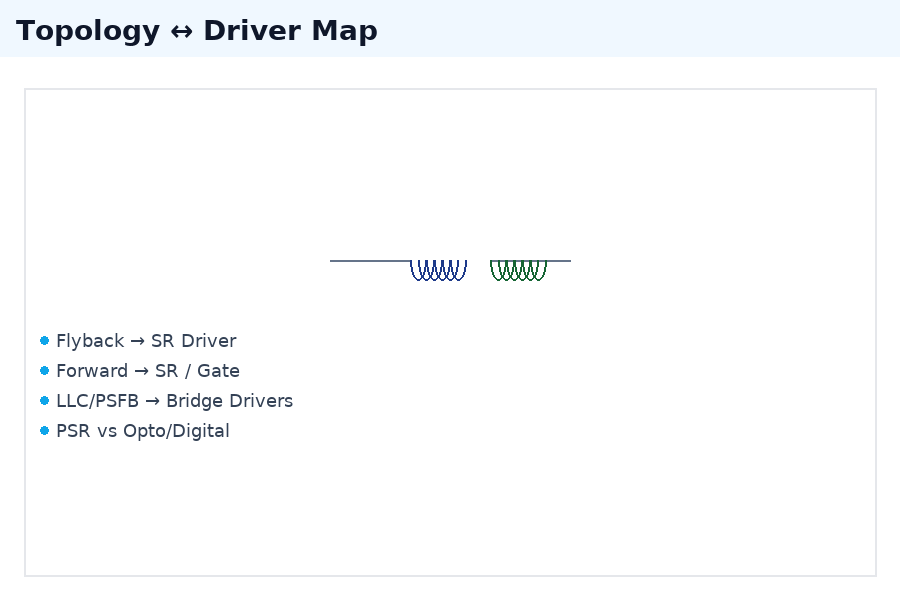
Flyback (PWM/QRC/ACF)
Go-to for small/mid power and multi-output. Pair a primary HV gate driver with a secondary SR driver/controller; ACF adds clamp/half-bridge-like timing. Watch leakage energy tuning and SR reverse-conduction limits.
Forward / Two-Transistor Forward
Lower ripple and better cross-regulation at higher power. Use primary driver plus dedicated SR controller. Validate demag/reset scheme and SR turn-off criteria.
Push-Pull / Half-Bridge / Full-Bridge (LLC/PSFB)
Soft-switching to kW class. Pair half/full-bridge drivers (isolated or high-side bootstrap) with synchronized secondary SR. Guard dead-time, CMTI, and resonant tolerance.
PSR vs Opto / Digital Isolation
PSR drops the optocoupler for BOM/robustness gains—great with Flyback/QRC. For top transient accuracy or multi-rail coordination, use digital isolation/optocoupler feedback with an SR controller.
Design checklist
- Select topology → size primary driver (VDS, peak Igate).
- Decide secondary device: diode vs SR driver/controller.
- Pick feedback: PSR for simplicity, or opto/digital isolator for performance.
- Verify isolation class, creepage/clearance, and CMTI for SiC/GaN.
Design Rules & Quick Calculations
Key design rules for optimizing SR driver timing, transformer design, driver power, switch stress, and efficiency distribution.
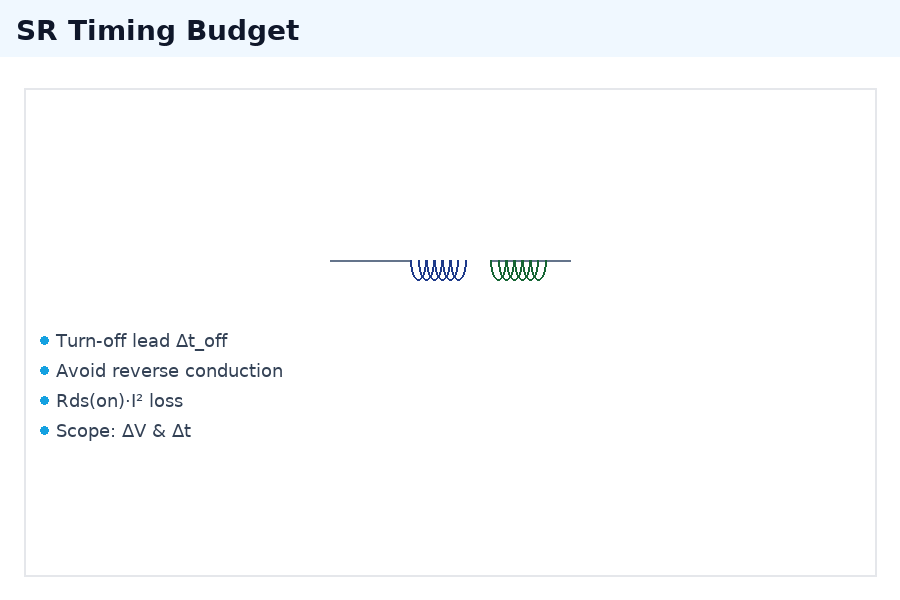
- SR Driver Timing: Ensure off-time margin \( \Delta t_{off} \) to prevent reverse conduction. Loss estimation: \( R_{DS(on)} \times I^2 \) for thermal rise.
- Transformer Design: Design transformer window and turns ratio to handle the duty cycle and peak current, maintaining clamping voltage margin.
- Gate Driver Power Source: Bootstrap or isolated bias power consumption \( I_{gate} \times \Delta V + \text{drive loss} \) needs to be within budget.
- Switch Stress: Ensure peak voltage stress \( V_{DS,pk} \) is within safe limits. Use RCD or active clamping for safe operation.
- Efficiency Allocation: Efficiently allocate losses into categories: conduction losses, core losses, switching losses, rectification losses, and driver losses.
Quick calculation rules:
- SR loss ≈ \( I^2 \times R_{DS(on)} \); conduction loss for SR ≈ \( I_{RMS}^2 \cdot R_{DS(on)} \).
- Gate drive loss ≈ \( Q_{G} \times V_{GS} \), consider rise/fall time and switch speed.
- Transformer winding window should accommodate the peak current with the appropriate turns ratio, ensuring clamp margin.
- Switch stress: \( V_{DS,pk} \) stress limited by device voltage rating; clamping must handle overshoot.
Isolation & Safety
Different isolation methods are critical to maintaining safety and compliance, ensuring driver performance and preventing faults in power systems.
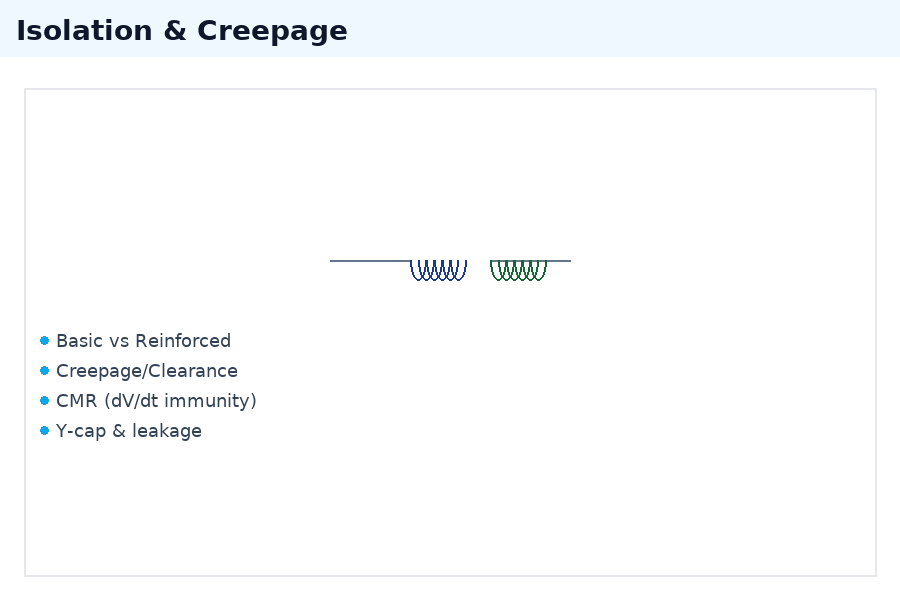
- Isolation Types: Optocouplers, digital isolation, and transformer coupling are used for different power levels and performance requirements.
- Creepage & Clearance: Proper creepage and electrical gaps are required to meet isolation standards for safety and fault prevention.
- Safety Standards: Relevant standards include IEC 62368-1 (general), IEC 60601-1 (medical), UL 1577, and IEC 61010 (industrial).
- Reinforced vs Basic Isolation: Reinforced isolation is for higher safety levels, while basic isolation is suitable for less critical applications.
- CMR (Common-Mode Transient Immunity): High CMR ratings are essential for preventing unintended triggering of drivers during transient events.
- Y-Capacitors & Common-Mode Chokes: Essential for balancing EMI suppression and controlling leakage current in isolated systems.
Key Design Considerations:
- Choose isolation method based on power levels and feedback performance: optocoupler, digital isolation, or transformer.
- Ensure creepage and clearance dimensions meet safety standards for isolation voltage and fault tolerance.
- Comply with safety standards such as IEC 60601 (medical), UL 1577 (isolation), and IEC 61010 (industrial). Ensure CMR is rated high enough to prevent accidental driver firing.
- Consider EMI suppression using Y-Capacitors and common-mode chokes to reduce leakage current in isolated systems.
Protections & Start-up/Brownout
Key protection mechanisms during start-up and brownout, including reverse current prevention, cross-conduction mitigation, UVLO/OVP windows, and start-up behavior.
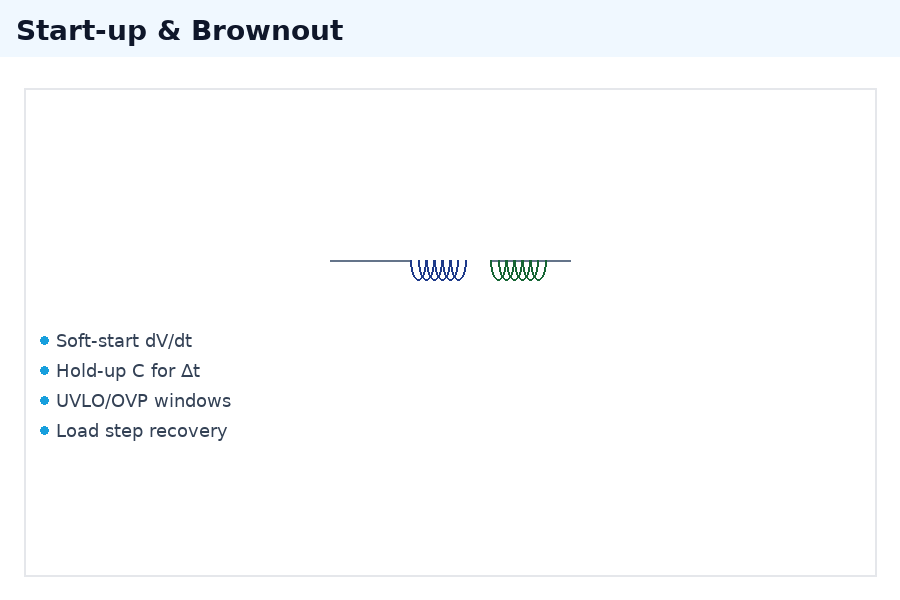
- Reverse Current & Cross-Conduction Prevention: Minimize dead-time to prevent reverse current; set SR reverse current thresholds.
- UVLO/OVP: Ensure proper UVLO (Undervoltage Lockout) and OVP (Overvoltage Protection) windows for both primary and secondary sides.
- Startup Behavior: Control bias-up sequence and soft-start slope \( dV/dt \) to limit inrush current (\( I_{inrush} \)).
- Brownout: Reserve enough margin for voltage sag; use hold-up capacitors to maintain operation during load transients.
Key Protection Guidelines:
- Ensure proper dead-time between primary switches to prevent cross-conduction or reverse current flow.
- Calculate soft-start slopes carefully, setting appropriate \( dV/dt \) to manage inrush current during power-up.
- Design for brownout recovery using capacitors and make sure the system can handle transient load shifts.
- Use PG (Power Good) and Hiccup mode to ensure that startup errors like voltage sag or overvoltage don’t affect the system.
Layout, EMI & Thermal
Optimize layout to minimize thermal and electrical loops, reduce EMI, and ensure efficient thermal management for power switches and drivers.
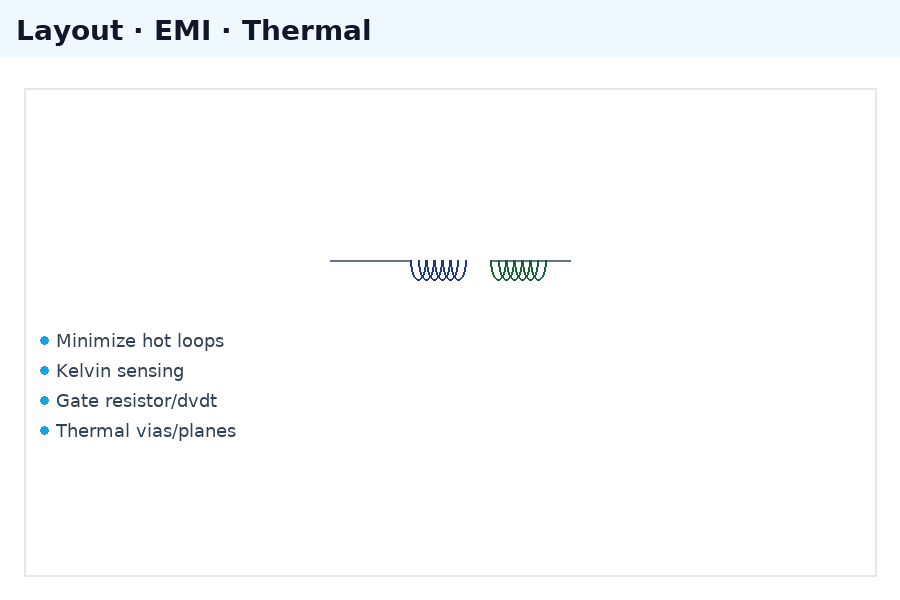
- Minimize Thermal/Electrical Loops: Design current loops as short and direct as possible to reduce EMI and thermal stress.
- Kelvin Sensing & Gate Driver Routing: Use Kelvin sensing for voltage and current measurements; keep gate drive routing as short and symmetric as possible.
- EMI Control: Identify hot current loops and reduce EMI by controlling \( dV/dt \) switching rates, selecting optimal gate resistors, and improving PCB shielding and grounding.
- Thermal Management: Optimize FET thermal vias, copper diffusion, and device thermal coupling for efficient heat dissipation.
Thermal & EMI Design Tips:
- Minimize current path loop area to reduce magnetic field interference and reduce EMI.
- Ensure all high-current and switching nodes are connected to wide copper pours to dissipate heat efficiently.
- Place power devices near the thermal vias and use proper PCB thermal management techniques to avoid hotspots.
- Use sufficient ground planes and shields to minimize EMI from high-speed switching nodes.
Validation Playbook
Testing and validation methods for key fault conditions, including oscilloscope waveform triggers, worst-case matrices, and fault injection.
- Oscilloscope Trigger Points: Primary switch node, VDS clamping, SR gate, VOUT droop \( \Delta V \), \( \Delta t \).
- Worst-Case Matrix: Test at Tmin/Tmax, maximum Cload, light/peak load, and PSR/optocoupler feedback types.
- Fault Injection: Simulate startup failures, OPP/short-circuit protection, SR mis-trigger, and brownout sweeps.
- Validation Criteria: No cross-conduction, \( \Delta V/\Delta t \) within budget, and no mis-trigger due to CMR interference.
Testing Guidelines:
- Ensure appropriate dead-time to prevent cross-conduction or reverse current.
- Soft-start slopes and \( \Delta V/\Delta t \) should be within designed margins to prevent startup failures.
- Perform fault injection for scenarios like overcurrent, short-circuit, SR mis-trigger, and brownout to assess system robustness.
- Monitor CMR (Common-Mode Rejection) to ensure no false triggering occurs due to transient interference.
Brand/IC Examples
A brief guide to choosing controllers and drivers from major brands for isolated power systems, highlighting high-power and highly integrated solutions.
TI / ST / Renesas
These brands offer high-efficiency controllers, including primary-side regulation (PSR), synchronous rectification (SR) drivers, and robust feedback mechanisms for isolated power designs.
onsemi / Microchip / NXP
onsemi and Microchip provide high-integrity solutions for high-power applications, while NXP focuses on isolators and drivers for automotive and industrial environments.
Infineon / Power Integrations
Infineon is known for high-power solutions with full-bridge and half-bridge drivers, while Power Integrations specializes in highly integrated isolated power supply solutions.
Selection Tips:
- For remote control or feedback, choose drivers with I²C or digital isolation.
- For high-power applications, use LLC/PSFB topologies with isolated driver solutions.
- For high integration and compact designs, consider solutions from Power Integrations or high-voltage primary-side integrated modules.
FAQs
How do I set SR turn-off advance (Δt_off) and verify on a scope?
Start with Δtoff ≈ 5–15% of the secondary conduction interval, then refine so the SR current crosses zero before the primary excites. Probe SR-Gate, SR-Drain, and VOUT; validate no reverse current notch and no overlap with primary. Re-check at Tmin/Tmax and peak load. See Design and Validation.
How high should CMR be to avoid driver mis-trigger?
For silicon MOSFET bridges, ≥50–100 V/µs is typical; for SiC/GaN with fast edges, target ≥100–150 V/µs (many designs prefer ≥200 V/µs). Validate with worst-case dv/dt and common-mode chokes/Y-caps in place. Ensure propagation-delay matching and Miller immunity. See Isolation and Protection.
Reinforced vs. Basic insulation—effects on creepage, clearance, and Y-capacitors?
Reinforced insulation demands longer creepage/clearance and tighter materials, often constraining placement and Y-cap values to meet leakage limits. Basic insulation may allow smaller distances but typically requires supplementary barriers. Confirm your standard (62368/60601/61010) and working/surge voltages. See Isolation and Layout.
LLC vs. PSFB—driver differences and magnetics window constraints?
LLC favors ZVS with frequency modulation, demanding precise half-bridge drive and resonant magnetics sizing; PSFB uses phase-shift for ZVS/ZCS windows and requires tight dead-time control. Magnetics windows must handle peak flux/current at extremes; PSFB typically scales better at higher power. See Topologies and Design.
How do I budget VOUT droop during brownout and switchover?
Define ΔV budget from load tolerance, then select hold-up capacitance via C ≥ (ILOAD·Δt)/ΔV. Include ESR step and control loop recovery. Validate with slow sags and fast dips at Tmin/Tmax, maximum Cload, and peak current. Coordinate PG/Hiccup thresholds. See Protection and Validation.
What triggers should I set on the scope for validation runs?
Use edge/timeout triggers on the primary switch node, SR-Gate, and VDS clamp. Add window triggers for VOUT droop ΔV/Δt and brownout sweeps. Correlate channels with PG and fault flags. Store reference cursors for Δtoff and dead-time checks. See Validation.
How to partition grounds and sense lines for clean measurements?
Separate power return and analog/sense returns; join at a quiet star point. Use Kelvin sense to the device pins. Keep SR and clamp loops tight; route gate returns parallel to gate traces. Shield high-dv/dt nodes and avoid stitching near sense vias. See Layout.
Which losses should I allocate first when closing the efficiency budget?
Start with conduction (MOSFET/SR RDS(on), winding copper), then core loss at switching frequency, followed by switching loss and clamp loss. Add driver and auxiliary bias power. Iterate magnetics and gate resistors until thermal margins pass. See Design.
How do I detect and prevent cross-conduction events?
Probe both gates and drains; any overlap of channel conduction implies insufficient dead-time or Miller injection. Increase dead-time slightly, add gate-stopper or Miller clamp, and verify symmetric routing. Re-test at voltage and temperature extremes. See Protection and Validation.
When should I choose digital isolation over an optocoupler feedback path?
Prefer digital isolation for tighter transient response, lower drift, integrated diagnostics, or multi-rail coordination. Optocouplers suit simpler cost-sensitive designs but age and vary with temperature. Confirm insulation class, working voltage, and CMR with your topology. See Isolation and Topologies.
What IC features help with remote policy control or telemetry?
Look for I²C/PMBus, programmable UVLO/OVP, adjustable dead-time, SR timing, and fault logs. Isolation for digital lines maintains barrier integrity. Combine with a sequencer/PSM if multiple rails interact. See ICs and related Protection settings.
How do I stress-test PSR vs. opto feedback paths fairly?
Sweep load and line transients, record settling time/overshoot, and repeat at Tmin/Tmax and max Cload. For PSR, include rectifier ripple and transformer tolerances; for opto, include CTR aging and temperature drift. Judge by ΔV/Δt budget and stability margins. See Validation and Design.
Resources & RFQ
Submit your BOM (48h)Sizing Worksheet (Excel)
Calculate transformer ratio, hold-up capacitance, SR losses, and gate-drive power. Pre-filled with design notes and quick rules.
Download XLSXDriver Timing Checklist (PDF)
Scope probes, trigger recipes, Δtoff margins, and no-overlap criteria for SR and bridge drivers; covers Tmin/Tmax corners.
Download PDFLayout & EMI Guide (PDF)
Current-loop minimization, Kelvin sensing, dv/dt control, shielding/grounding, and thermal via patterns with practical placement tips.
Download PDF
